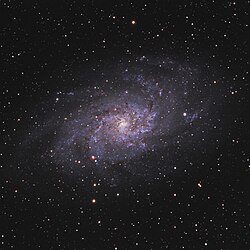Sérsic profile
The Sérsic profile (or Sérsic model or Sérsic's law) is a mathematical function that describes how the intensity of a galaxy varies with distance from its center. It is a generalization of de Vaucouleurs' law. José Luis Sérsic first published his law in 1963.[1]
Definition
The Sérsic profile has the form
where is the intensity at . The parameter , called the "Sérsic index," controls the degree of curvature of the profile (see figure). The smaller the value of , the less centrally concentrated the profile is and the shallower (steeper) the logarithmic slope at small (large) radii is:
Today, it is more common to write this function in terms of the half-light radius, Re, and the intensity at that radius, Ie, such that
where is approximately for . can also be approximated to be , for .[2] It can be shown that satisfies , where and are respectively the Gamma function and lower incomplete Gamma function. Many related expressions, in terms of the surface brightness, also exist.[3]
Applications


Most galaxies are fit by Sérsic profiles with indices in the range 1/2 < n < 10. The best-fit value of n correlates with galaxy size and luminosity, such that bigger and brighter galaxies tend to be fit with larger n. [5] [6] Setting n = 4 gives the de Vaucouleurs profile:
which is a rough approximation of ordinary elliptical galaxies. Setting n = 1 gives the exponential profile:
which is a good approximation of spiral galaxy disks and a rough approximation of dwarf elliptical galaxies. The correlation of Sérsic index (i.e. galaxy concentration[7]) with galaxy morphology is sometimes used in automated schemes to determine the Hubble type of distant galaxies.[8] Sérsic indices have also been shown to correlate with the mass of the supermassive black hole at the centers of the galaxies. [9]
Sérsic profiles can also be used to describe dark matter halos, where the Sérsic index correlates with halo mass.[10] [11]
Generalizations of the Sérsic profile
The brightest elliptical galaxies often have low-density cores that are not well described by Sérsic's law. The core-Sérsic family of models was introduced [12][13][14] to describe such galaxies. Core-Sérsic models have an additional set of parameters that describe the core.
Dwarf elliptical galaxies and bulges often have point-like nuclei that are also not well described by Sérsic's law. These galaxies are often fit by a Sérsic model with an added central component representing the nucleus. [15] [16]
The Einasto profile is mathematically identical to the Sérsic profile, except that is replaced by , the volume density, and is replaced by , the internal (not projected on the sky) distance from the center.
See also
References
- ^ J. L. Sérsic (1963), Influence of the atmospheric and instrumental dispersion on the brightness distribution in a galaxy
- ^ L. Ciotti and G. Bertin (1999) Analytical properties of the R1/mlaw
- ^ Graham, A.W. and Driver, S.P. (2005), A Concise Reference to (Projected) Sérsic R1/n Quantities, Including Concentration, Profile Slopes, Petrosian Indices, and Kron Magnitudes
- ^ G. Savorgnan et al. (2013),The supermassive black hole mass-Sérsic index relations for bulges and elliptical galaxies
- ^ N. Caon et al. (1993), On the Shape of the Light Profiles of Early Type Galaxies
- ^ C. Young & M. Currie (1994), A New Extragalactic Distance Indicator Based on the Surface Brightness Profiles of Dwarf Elliptical Galaxies
- ^ Trujillo, I., Graham, Alister W., Caon, N. (2001), On the estimation of galaxy structural parameters: the Sérsic model
- ^ A. van der Wel (2008), The morphology-density relation: a constant of nature
- ^ A. Graham & S. Driver (2007), A Log-Quadratic Relation for Predicting Supermassive Black Hole Masses from the Host Bulge Sérsic Index
- ^ D. Merritt et al. (2005), A Universal Density Profile for Dark and Luminous Matter?
- ^ D. Merritt et al. (2006), Empirical Models for Dark Matter Halos. III. Nonparametric Construction of Density Profiles and Comparison with Parametric Models
- ^ A. Graham et al. (2003), A New Empirical Model for the Structural Analysis of Early-Type Galaxies, and A Critical Review of the Nuker Model
- ^ I. Trujillo et al. (2004), Evidence for a New Elliptical-Galaxy Paradigm: Sérsic and Core Galaxies
- ^ B. Terzić & A. W. Graham (2005), Density-potential pairs for spherical stellar systems with Sérsic light profiles and (optional) power-law cores
- ^ A. Graham & R. Guzmán (2003), HST Photometry of Dwarf Elliptical Galaxies in Coma
- ^ P. Cote et al. (2006), The ACS Virgo Cluster Survey. VIII. The Nuclei of Early-Type Galaxies
External links
- Stellar systems following the R exp 1/m luminosity law A comprehensive paper that derives many properties of Sérsic models.
- A Concise Reference to (Projected) Sérsic R1/n Quantities, Including Concentration, Profile Slopes, Petrosian Indices, and Kron Magnitudes.








![{\displaystyle I(R)=I_{e}\exp \left\{-b_{n}\left[\left({\frac {R}{R_{e}}}\right)^{1/n}-1\right]\right\},}](https://wikimedia.org/api/rest_v1/media/math/render/svg/364fa183231421cdf536519b4f8f1ea1b2f294b4)











